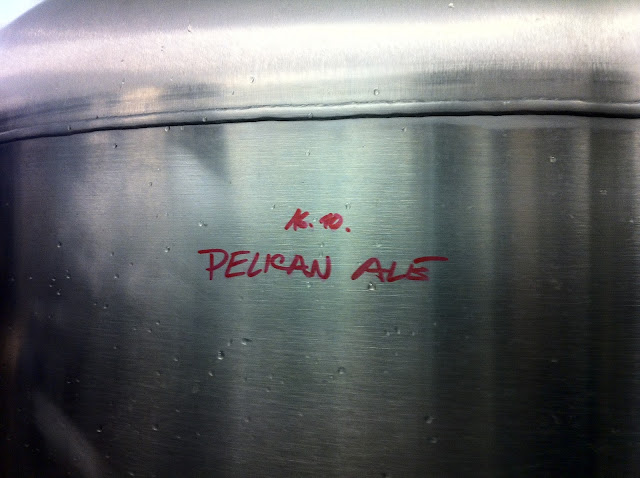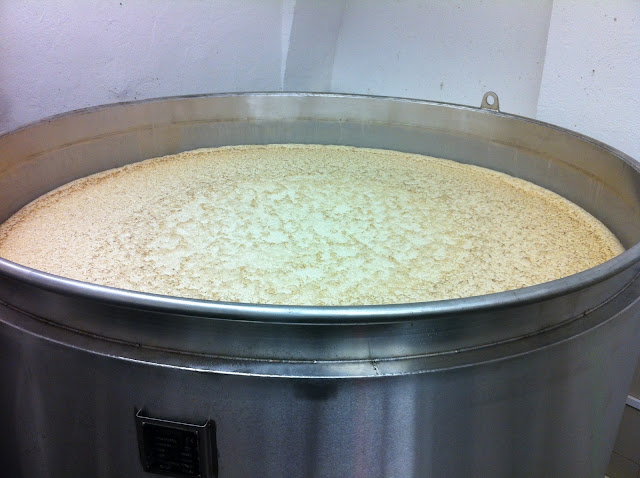Where Czech and Oregon Beer Met
The Czech Republic, not for reasons strictly of geography, is far, far from the American consciousness. Don't talk polotmave, don't mention ales. All we know is pilsner (only a part of the landscape), and we don't really even understand that. It has been one of my great pleasures to experience the beer here--in some ways it is closely related to Oregon beer. For one thing, a good lot of the lagers here are unfiltered. They're hazy like Oregon skies (and beers). Of course, they're also hoppy (though not always bitter). Even more, it's like Oregon in the sense that it's this huge, rich scene no one knows that much about.
As I alluded to yesterday, one of the key things is malt. Moravian and Bohemian malt is particular. The grains are smaller, and the malting--often floor-malted--is rougher, less efficient. In the US, base malts are essentially sugar. If you want color or flavor, add specialty malt as needed. In Czech, the base malts are full of color and character. To get a splash of color, you may not need Munich. These "pilsner" malts are twice as dark as what Americans think of. The beers here are deeper colored, and--as with English floor malts--softer, richer, grainier.
Another thing that's key to understanding beer here: it's not all pale lager. Amber (polotmave) and dark lagers (tmave) are common, and they're not exactly like marzens and schwarzbiers. They bear the stamp of Czechness--those round malts, the spicy hops, and a few of the tmaves I've tried were flat-out roasty and stout-like. Czech beers also run the range of strengths, not only colors, so you might have a light pale, a medium dark, and a strong pale. Beers are identified by both color and strength--the shorthand is to use the beer's original gravity, as expressed in Plato, 10, 12, 16, etc.
And those are the standards. As everywhere, the Czech Republic is not immune to the influence of the craft beer movement, so breweries are also dabbling in ales, including American style eepahs (IPAs), imperial stouts, and so on.
And here we come to the place where the very remote places travel through space to meet--and blow my mind. Max Brahnson, the great chronicler of Czech beers, has generously given
me two days of his time in an intensive tutorial of the country's beer. Today, as we toured Břevnovský, a new
Brewery in an old Prague monastery (though not a project of the monastery), something remarkable happened. I was slowly ambling by the conditioning tanks when I came across one called "Pelican Ale." curious, I asked about it. By chance, a coupe had come in with empty bottles and were setting up a hand-fill line. Max explained that the tank was actually theirs--they were gypsy brewers using the new monastery brewery's excess capacity. Max relayed, off-handedly, that the Pelican was some beer they'd made with an American brewer. "Really!" I said. A few back-and-firths confirmed: the brewer was Darron Welch, from Oregon's own Pelican, who was in that very building two weeks ago. The beer was a hoppy pale made with Czech malt and Czech and American hops. (It was totally Oregonian--saturated late-addition hopping--and made me nostalgic.)
Earlier in the day, Max took me to Únětický Pivovar (pivovar means brewery and may be the only Czech ive been able to master). It's a new brewery established on the site of one from the 18th century. The beer is that wonderful unfiltered stuff which here flows hazy straight from conditioning tanks. You hold up a glass and it looks like Double Mountain's Vaporizer and smells maybe not a lot less hoppy. I told Max: "I wish I could take a keg of this back with me just to show Americans what Czech beer can be." the irony is that, despite Bohemia's immense contribution to the beer wod, we don't really understand Bohemian beer. Even more strange: based on what I've seen here in Prague, Czechs may actually have a better sense of our beer.
As I alluded to yesterday, one of the key things is malt. Moravian and Bohemian malt is particular. The grains are smaller, and the malting--often floor-malted--is rougher, less efficient. In the US, base malts are essentially sugar. If you want color or flavor, add specialty malt as needed. In Czech, the base malts are full of color and character. To get a splash of color, you may not need Munich. These "pilsner" malts are twice as dark as what Americans think of. The beers here are deeper colored, and--as with English floor malts--softer, richer, grainier.
Another thing that's key to understanding beer here: it's not all pale lager. Amber (polotmave) and dark lagers (tmave) are common, and they're not exactly like marzens and schwarzbiers. They bear the stamp of Czechness--those round malts, the spicy hops, and a few of the tmaves I've tried were flat-out roasty and stout-like. Czech beers also run the range of strengths, not only colors, so you might have a light pale, a medium dark, and a strong pale. Beers are identified by both color and strength--the shorthand is to use the beer's original gravity, as expressed in Plato, 10, 12, 16, etc.
And those are the standards. As everywhere, the Czech Republic is not immune to the influence of the craft beer movement, so breweries are also dabbling in ales, including American style eepahs (IPAs), imperial stouts, and so on.
And here we come to the place where the very remote places travel through space to meet--and blow my mind. Max Brahnson, the great chronicler of Czech beers, has generously given
me two days of his time in an intensive tutorial of the country's beer. Today, as we toured Břevnovský, a new
Brewery in an old Prague monastery (though not a project of the monastery), something remarkable happened. I was slowly ambling by the conditioning tanks when I came across one called "Pelican Ale." curious, I asked about it. By chance, a coupe had come in with empty bottles and were setting up a hand-fill line. Max explained that the tank was actually theirs--they were gypsy brewers using the new monastery brewery's excess capacity. Max relayed, off-handedly, that the Pelican was some beer they'd made with an American brewer. "Really!" I said. A few back-and-firths confirmed: the brewer was Darron Welch, from Oregon's own Pelican, who was in that very building two weeks ago. The beer was a hoppy pale made with Czech malt and Czech and American hops. (It was totally Oregonian--saturated late-addition hopping--and made me nostalgic.)
Earlier in the day, Max took me to Únětický Pivovar (pivovar means brewery and may be the only Czech ive been able to master). It's a new brewery established on the site of one from the 18th century. The beer is that wonderful unfiltered stuff which here flows hazy straight from conditioning tanks. You hold up a glass and it looks like Double Mountain's Vaporizer and smells maybe not a lot less hoppy. I told Max: "I wish I could take a keg of this back with me just to show Americans what Czech beer can be." the irony is that, despite Bohemia's immense contribution to the beer wod, we don't really understand Bohemian beer. Even more strange: based on what I've seen here in Prague, Czechs may actually have a better sense of our beer.



